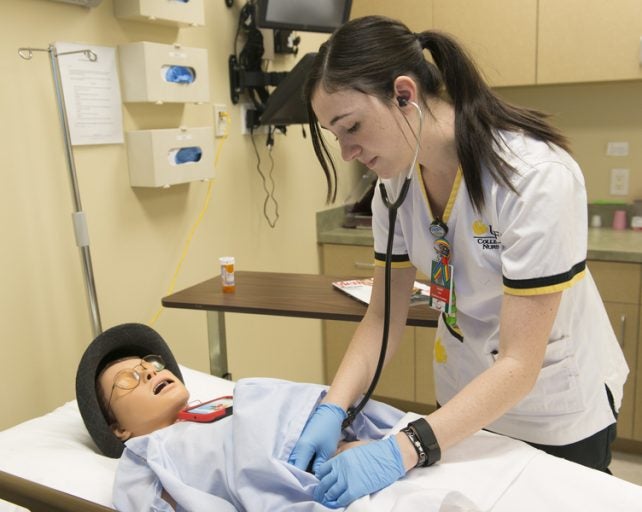The statistics don’t lie.
Transgender people are three times more likely to attempt suicide, twice as likely to be homeless, six to eight times more likely to suffer from depression, and twice as likely to be assaulted or victimized in some way.
If they need health care, the road gets even muddier.
“What if you identify as man, but you need an OB-GYN exam, your pap smear?” asks Desiree Diaz, assistant professor of nursing at UCF.
“Imagine it: You’re a guy sitting in a roomful of pregnant women waiting to be seen by a doctor. How would you feel? Would you stay, or leave? Maybe you don’t go at all.”
Diaz has partnered with former colleague Annette T. Maruca, an associate clinical professor at the University of Connecticut, to help address transgender care in nursing. Nurses are among the first-line health professionals who will see transgender people.
At a time when transgender issues are seeing increased attention nationally over laws mandating gender-specific bathrooms and last summer’s Pulse shooting that targeted the LGBTQ community, Diaz and Maruca say it’s even more important to teach caregivers how to help a population that often shuns heath care.
The UCF College of Nursing is among a growing number of programs that use simulation technology– to educate nurses on how to provide care for a myriad of cases. The simulations, which use a high-fidelity human patient simulator, or mannequin, that speaks, simulates medical symptoms and acts much like a patient would, teach nursing students how to provide knowledgeable and compassionate care.
Diaz and Maruca recently conducted a study with students on both UCF’s and UConn’s campuses to address how the attitudes of these future nurses would impact quality care for transgender patients. About 170 nursing students from both colleges participated in a simulation using “Taylor,” a transgender youth who identifies as male, but was born female. Taylor complains of anxiety, stress and migraines as his physical ailments. As the simulation progresses, he talks about his feelings of alienation from co-workers; they seem hostile towards him, he tells them.
“Taylor is very real. The students forget after a while that he’s a mannequin,” said Diaz who is one of only 22 experts in the world who are certified as advanced in their practice of healthcare simulation. ”Because he’s talking to them, reacting to them, and becoming real, they begin to empathize.”
Diaz and Maruca presented their findings at the International Nursing Association for Clinical Simulation and Learning conference and their article was recently published online in an international journal.
What they learned was that as a younger generation of students enters the nursing workforce, there are fewer biases against transgender people. That, however, doesn’t mean they are comfortable or knowledgeable about providing this population with quality care.
With a mean age of 22, students in the study quickly forgot sexual orientation and focused on quality of care, Diaz and Maruca found; yet, some felt it was not their responsibility to be educated about transgender issues, and were uncomfortable discussing the topic with the patient.
“Some of them were like, ‘Why does this even matter?’” Diaz said. “But you have to think that this person needs multiple issues addressed: What room do we put him in? Are his physical symptoms related to his work stressors? Does he need mental health? Is he socially isolated and could that have an impact? What medications is he taking? Is that a factor?”
During clinical education, students in health care fields rarely have access to transgender people, who make up a tiny fraction of the general population. And in most nursing programs, there are only about two hours of education on this specific population. UCF and UConn offer an enhanced curriculum with the added simulation hours.
“We found the students were trans-friendly, but not necessary trans-educated,” Maruca said.” We want them to go out and be leaders in beginning these discussions.”
Each simulation runs about a half hour, with the transgender patient, Taylor, feeling anxious and becoming increasingly suspicious of the nursing staff. He listens to music on his headphones “to keep calm.” He’s nervous and paranoid: “Are you guys laughing at me?” And, “No one is listening to me,” he pleads.
The student nurses try hard to ask him general questions (“What music do you like?” “What’s happening at work?”), all the while coaxing him to stay calm and let them figure out how to help him.
After the simulation is over, the students gathered with their professor for a debriefing.
“I felt a little helpless for him,” said Haley Boyle, a senior who graduates in May and is president of the Student Nurses Association at UCF-Orlando. “I felt like he had other things stressing him out. I wanted to ask more about his transition and how he was dealing with that.”
That’s exactly what Diaz and Maruca hope to teach the students.
“What were the social queues that were important? What questions made you realize what he was going through? What information should you eliminate as you’re treating Taylor?” Diaz said, explaining that the students need to think not only about his immediate symptoms but also his emotional, psychological and social stressors.
Senior Nancy Rupp said she feels better prepared by the simulation experience.
“It’s important that we can act like nurses treating him so that if we make a mistake, it’s in a sim, not in the real world,” she said. “This is a situation we might not have the chance to experience in clinicals. It allows us to ask questions and hopefully find you’re prepared for a similar situation later.”
